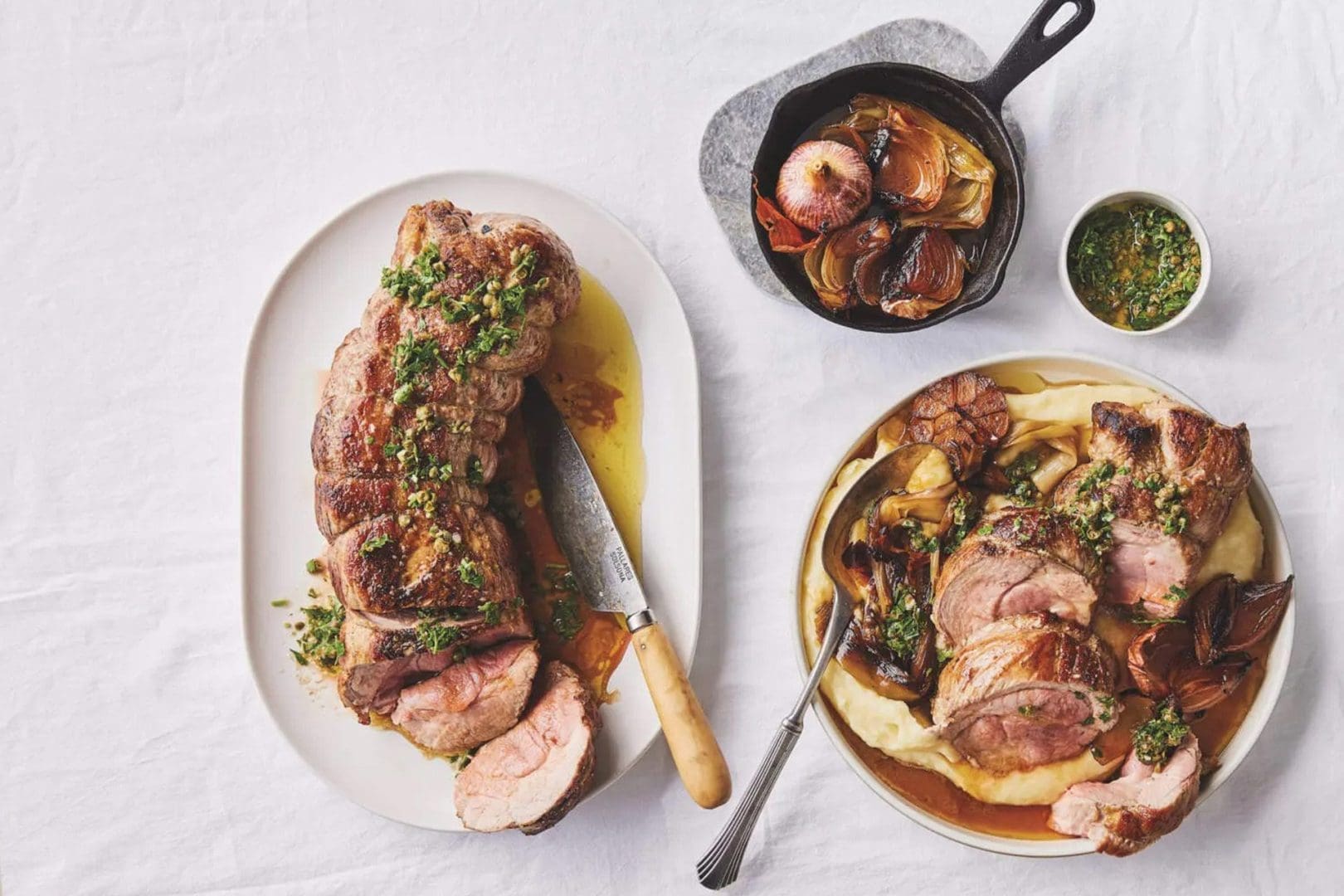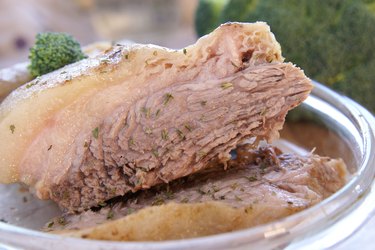Neckbones from pork usually only have a little meat on them, but they can make broths, sauces, and soups taste better. Boiling neck bones the right way can make a cheap main dish, a side dish, or a way to spice up greens, beans, peas, and other vegetables.
Pork neckbones taste best when simmered or slow-cooked. Serve them with veggies or add them to soups, broths and stews for extra flavor and nutrition.
Pork neck also known as pork collar, is a cut of meat from the fatty area around the neck of the pig. It’s a popular choice for slow cooking and adds great flavor to soups stews, and other dishes. But is this tasty cut actually good for you? Let’s take a closer look at the nutrition, benefits, and potential risks of pork neck.
Nutrition Profile of Pork Neck
Pork neck is high in fat and calories compared to other cuts of pork A 3 ounce serving contains
- Calories: 210
- Fat: 15g
- Saturated fat: 5g
- Protein: 15g
It’s a good source of vitamins and minerals like:
- Niacin
- Vitamin B6
- Vitamin B12
- Zinc
- Selenium
It also contains iron, phosphorus, and thiamine.
The high fat content makes pork neck flavorful for stews and braises. But it also means it’s high in saturated fat and cholesterol.
Potential Benefits of Pork Neck
In moderation pork neck provides some potential benefits
-
High-quality protein – Pork is a complete protein containing all the essential amino acids. The protein in pork neck promotes muscle growth and maintenance.
-
B vitamins – Pork neck is high in niacin, B6, and B12. These aid in metabolism, nerve function, and red blood cell production.
-
Zinc and selenium – These minerals support immune function and thyroid health. Pork neck is a significant source.
-
Iron – The iron in pork neck helps prevent anemia and aids in oxygen transport in the body.
-
Flavor – The fat marbling gives pork neck lots of juicy, rich flavor for stews, soups, braises.
Potential Risks of Consuming Pork Neck
There are also some potential downsides to keep in mind:
-
High in saturated fat – The 15g of fat per serving, including 5g saturated fat, is high given the serving size. Too much saturated fat raises cholesterol levels.
-
May contain parasites – Undercooked pork can contain parasites like trichinella or tapeworms. Thorough cooking kills parasites.
-
Can be high in sodium – Cured and processed pork neck often contains added sodium. This may need to be limited for those restricting sodium.
-
Allergies – Some people are allergic to pork and need to avoid it entirely. Allergies are usually to proteins found in the meat.
Is Pork Neck Healthy Overall?
In moderation, pork neck can be part of a healthy diet for most people. The nutrients it provides may help offset the high saturated fat content when consumed occasionally. Those with sodium restrictions or pork allergies should avoid it.
To make the healthiest choices when buying and cooking pork neck:
-
Choose uncured, unenhanced cuts to limit sodium.
-
Trim excess fat before cooking to reduce saturated fat intake.
-
Cook it thoroughly to at least 145°F internally to kill any parasites.
-
Limit portion sizes to 3-4 ounces in a meal.
-
Balance with vegetables, fruits, whole grains for overall healthy diet.
-
Substitute leaner cuts of pork or other protein sources if concerned about fat content.
So is pork neck healthy? In small amounts, yes, it can provide important vitamins and minerals. But moderation is key given the high calorie, saturated fat, and sodium content. Overall, pork neck’s impact depends on your individual dietary needs and health goals.

Slow Cook Pork Neckbones
Pork neckbones are an affordable ingredient in many traditional comfort food recipes. Neck bones and potatoes pair well with other vegetables, such as carrots and Italian green beans.
Video of the Day
Boiling tougher cuts of meat in liquid is a simple cooking process thats widely used for tenderizing. Simmering the bones over low heat will help break down the collagen, or connective tissue in the meat. It also draws out marrow that contains minerals, such as calcium, according to the U.C. San Diego Health.



The key to getting all the meat off is to slow cook pork neckbones. You can boil neck bones on the stove, but slow cookers keep the temperature more even and keep the heat in better.
Put some oil in the bottom of the slow cooker before you put the pork neck bones in it so that they don’t stick. Universities in Wyoming say that when you add vegetables like potatoes, they cook more slowly than meat when the heat is moist. So put them at the bottom of the pot.
By adding vegetables, the resulting broth will add nutrients to your meal. For example, adding tomatoes and carrots will provide phytochemicals, such as lycopene and carotenoids, notes the U. C. San Diego Health. Plus, the acid in the tomatoes will help tenderize the meat.



Adding some chopped ginger to your broth can also help tenderize the meat from the pork neckbones. There was a study in February 2016 in the Journal of Livestock Science that said ginger rhizome has a strong enzyme that makes tough meat more tender. Additionally, ginger exhibits antioxidant properties.
When youre ready to add the neckbones, rinse them first to remove loose particles, excess cartilage or fat. Fill your slow cooker with water, broth or sauce to no more than two-thirds full.
For the first hour, the University of Wyoming says to cook on high heat so that the food quickly reaches the safest temperature of 135 degrees Fahrenheit. Then, they say to turn the heat down to low and let the temperature rise slowly. The surrounding liquid should maintain a temperature of 180 to 190 degrees F to kill microorganisms.
Read more: 10 Cooking Tips Every Beginner Chef Must Know
While the food is still cooking, add whole herbs and spices instead of ground ones for the best flavor. Pepper, cayenne and Tabasco sauce tend to become bitter when cooked for longer periods of time. Some good herbs to use include garlic, curry, Italian seasoning and coriander.
The Nutritional Benefits of Neckbones
Pork neck bones are a good source of protein and minerals. Each cooked neckbone delivers 85.5 calories after the bone is removed, according to the USDA. Neckbones dont contain any carbohydrates, fiber or sugar. They provide 1.2 grams of saturated fats and 32 milligrams of cholesterol per piece (about 1.6 ounces).
Some important minerals in pork neck bones include:
- Calcium: 6.6 milligrams
- Iron: 0.5 milligrams
- Magnesium: 9.4 milligrams
- Phosphorus: 117 milligrams
- Potassium: 158 milligrams
- Zinc: 1.5 milligrams
- B vitamins, including thiamine, riboflavin, niacin, B6, B12 and folate
Read more: Bone Soup Nutrition
Ounce for ounce, pork neck has fewer calories than chicken necks. Pork necks deliver 0. 9 grams of total fat per ounce. Chicken necks contain 3. 6 grams for the same amount, but chicken necks have slightly more protein. If you cook an ounce of beef neck bones without the bone, it has 33 calories, 2 grams of fat, and 3 grams of carbs. 3 grams of protein, according to the USDA.
Health benefits of Pork: Is it even healthy?
FAQ
Is pork neck lean or fatty?
Is pork neck bone healthy?
What is the healthiest form of pork?
Is pork neck high in fat?
What is a pork neck pig?
Suitable for special occasions or everyday gourmet dining. A pork neck, also known as pork collar or pork neck fillet, is a cut that comes from the upper part of the pig’s neck area, close to the shoulder or blade. Depending on the region, this cut may have different names, but it generally refers to the meat from this specific part of the pig.
Is pork neck good for You?
Pork neck is a nutrient-rich meat that provides a good source of protein, vitamins, and minerals. A 100-gram serving contains approximately: The versatility of pork neck allows for a wide range of cooking methods, each highlighting its unique flavor and texture. Braising is an ideal technique for tenderizing the coarser fibers of pork neck.
Is pork neck a good cut?
Pork neck, often overlooked in favor of more popular cuts like tenderloin or ribs, is a succulent and flavorful gem that deserves a place on your culinary radar. This versatile cut offers a unique combination of richness, tenderness, and affordability, making it an excellent choice for various cooking methods and dishes.
Is pork neck good for grilling?
Grilling pork neck over high heat sears the exterior, creating a flavorful crust while keeping the interior juicy. It is a great option for quick and easy grilling. Pork neck has a mild flavor, making it a blank canvas for a variety of seasonings.
